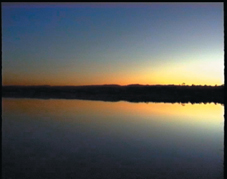leigh hobba – the space of presence: time spans
judith abell

Leigh Hobba
I’m looking at Leigh Hobba’s face from 1982, the corners of his large tortoise shell glasses are rounded in the style of the time. Across five images he smiles or stares impassively. Each fragmented image is composed of squares that are cut, mixed and re-pasted to rebuild his portrait in a way reminiscent of Hockney’s collages of the same time. Combined with its title—Came so quickly from winter in Paris to Summer in Hobart that I could still feel the cold in my body—the series evokes the common sensation of arriving on another side of the world before your body has caught up. This work, mounted near the entry, seems at odds with the others at first, but on reflection, sets the scene for The Space of Presence, a retrospective of the last twenty years of Hobba’s practice.
Leigh Hobba is a prolific artist who has travelled widely, making work since the mid 70s. By the time he graduated from Elder Conservatorium in Adelaide, he was already excited by avant-garde approaches to working with sound, like John Cage’s, challenging methods for making music, embracing chance and using mechanical means to generate compositions. Since then Hobba has built a contemporary art practice utilising sound, video and performance. However for many, The Space of Presence offers the first viewing of the 12 pieces in the show.
As the first set of images suggests, a continuous thread linking all the works is the self, the body and the passing of time. The focus in Hobba’s work is the way he is affected by particular environments, from dense cities to remote Tasmanian wilderness.
This is a song about Hobart and some of the people who live here, is a video and sound work with a single, large screen display. Donning headphones, I listened to Hobba’s monotone recital of diary entries from a time in Paris. He mirrors me in the video, also wearing headphones, his stare unwavering. The monologue is a fast-spoken narration of ordinary events and acute observations, often humorous. Towards the end of the loop Hobba speeds up the recital to the point where the words take on an overlapping song-like rhythm with phrases repeated, broken down, rearranged.
I’ve seen Mycenae glistening over the wine dark sea, is a compelling, sensual installation enclosed in a dark, brick-red space dominated by a large projection of mist softly revealing and concealing a rocky outcrop. As if to emphasise its intermittent absence, a thick black line overlayed on the video provides the outline of the outcrop, even when it cannot be seen. Three small screens placed on the floor around the room show Hobba’s young, sleeping son. Lying on a black background, his pale skin and red curls angelic, the boy is so still his breathing is almost imperceptible. A long, low bench, placed diagonally in the centre of the space is covered with large rocks, each the size of a dinner plate. On three walls, door-sized panels, striped with mirrored perspex are fixed horizontally and vertically to reflect the greys of the mist and movement of visitors. The imperfections in the perspex stripes recreate the facets of the rock face. Having spent some time in the room, I come away with a sensation that is difficult to describe and the exquisite image of the boy fixed in my mind—his tiny breaths are the key here. Somehow.
There is an overwhelming sense in the gallery of time passing and the presence of a man for whom this is a preoccupation. While the works appear to be intimately connected to Hobba’s sense of self, they lack self-consciousness—there is no compulsion to be an artist of a particular time or type—and many pieces are unapologetically obtuse. He is quoted in the catalogue: “For me the act of recording is the act of documentation—a document of experience—in crafting that documentary, one might indeed create good fiction; in creating fiction one might equally create a good documentary.” Like the act of staring at rocks in the mist, I don’t think that we need to necessarily understand this exhibition, we just need to experience, to register its effect in our bodies.
Leigh Hobba, The Space of Presence, curator Craig Judd; Tasmanian Museum and Art Gallery, Hobart, March 16-April 29; Ten Days on the Island, March 23-April 1
RealTime issue #78 April-May 2007 pg. web






